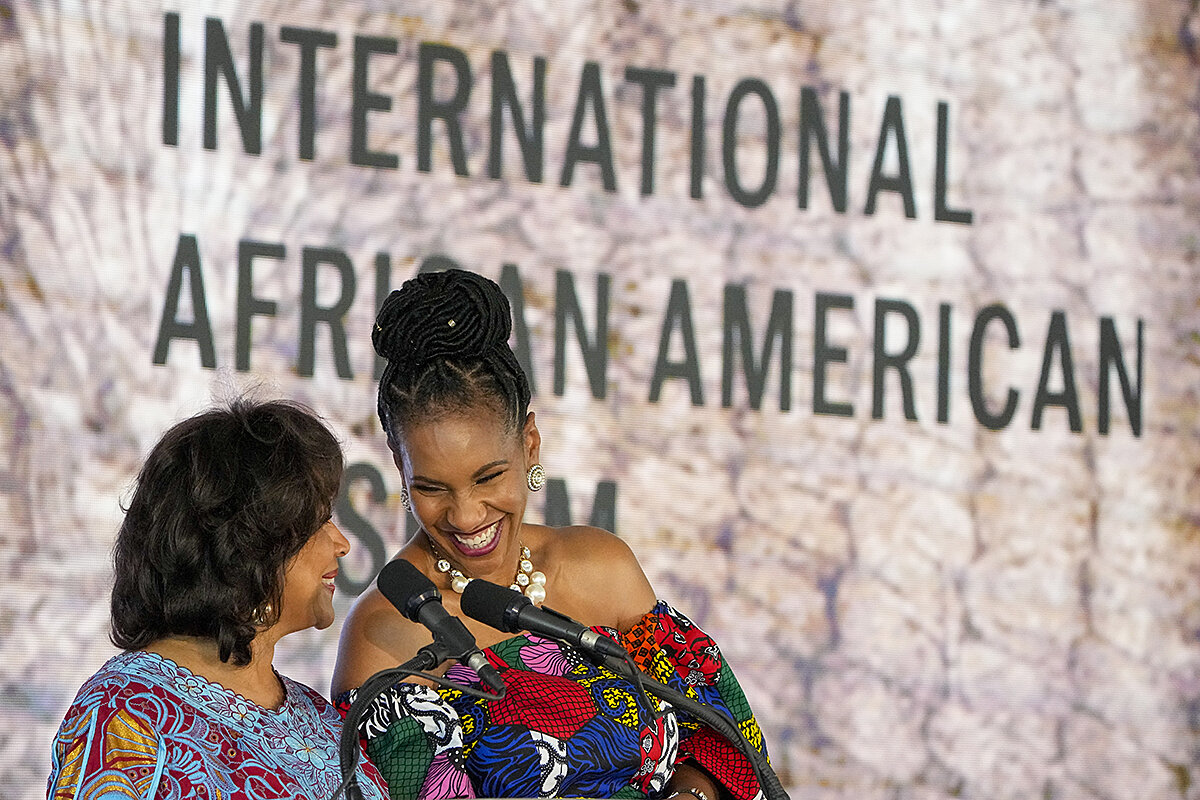‘This ground is sacred.’ How a new museum reclaims history from horror.
Loading...
| Charleston, S.C.
How does ground zero become hallowed ground?
The new International African American Museum (IAAM) in Charleston, South Carolina, is an exercise – rather, an exultation – in the importance of such work.
As the museum’s director of education and engagement for faith-based communities, the Rev. DeMett Jenkins identifies the importance of spiritual healing and community networking in the museum’s development. As a proud “Gullah Geechee girl” and the granddaughter of Esau and Janie Jenkins, local trailblazers in health care and transportation, she appreciates the social justice component of this “sacred space.”
Why We Wrote This
A story focused onHow do you turn a site of horror into one of healing? The question of how to honor those whose lives were stolen informs every detail at the new International African American Museum in Charleston, South Carolina.
“That’s why the building is lifted 13 feet up, because we didn’t want – the architects didn’t want – to just plant a building on this ground,” Reverend Jenkins says. “Why? When the souls of our ancestors stepped on it? We want to make sure that we put our feet within their feet and that we live out the prayers that they have been praying for.”
It is perhaps fitting, then, that a worship service kicked things off for the museum at the iconic Morris Brown African Methodist Episcopal (AME) Church in Charleston on June 22. Brown was one of the founders of the AME Church and founded the former Hampstead Church, now known as Emanuel AME Church. “Mother Emanuel” has been the target of multiple racist attacks since its founding, including in 2015, when a white teenager opened fire and murdered nine Black people at prayer.
Ms. Jenkins called the service a “celebration of liberation,” and spoke about making history a priority in faith communities.
“Besides school and home, we spend most of our time in somebody’s house of worship,” she explains, sitting in an office adjacent to the museum’s Center for Family History. “And so we have the responsibility of teaching and educating and informing just as much as any mother or father in their home. And so this ground is sacred.”
I attended the museum on the last day of June, a few days after its grand opening on June 27. The museum was carefully curated – a meticulous labor of love. Exhibits focused on “local, state, national and international” components of Black history and chronicled a history from 300 B.C. to the present day.
Second in size to only the National Museum of African American History and Culture in Washington, D.C., the International African American Museum is home to 12 permanent exhibitions, including nine galleries and a special exhibitions gallery, which will rotate two to three exhibits annually. Through Aug. 6, one of those displays, “Men of Change: Power. Triumph. Truth.” will highlight the various contributions of Black activists and entertainers from James Baldwin to Kendrick Lamar.
“They say it took almost 20 years to get here,” says museumgoer Ray Alls. “I can see that when you look at the attention to detail. It’s beautiful – long overdue.”
That detail begins on the exterior, where the museum rests at Gadsden’s Wharf. The beauty of the harbor belies the horrors of the country’s history of chattel slavery. The wharf was the first destination in North America for an estimated 100,000 people who were forced into slavery.
“People kind of know that Charleston was a port [for enslaved peoples from Africa], but didn’t really know where and how many. Based on what stats you read, sometimes you’ll see 40% and sometimes you’ll see 48% ... of our African ancestors came right through Charleston,” Ms. Jenkins says. “I always challenge myself when I hear myself say ‘came here,’ I correct myself and say they were ‘forced here.’”
Consider a duo of life-size portraits that rest in close proximity in the American Journeys exhibit, similar in depiction but with a gripping and profound difference.
They tell the story of Frazier Baker, a Black teacher who was appointed postmaster in Lake City, South Carolina, in 1897. He was an appointee of President William McKinley, who sought to promote Black Republicans in the aftermath of his inauguration.
Baker quickly became the target of white angst, and then, white violence. On the morning of Feb. 22, 1898, a mob raided and fired upon Baker’s home – also the town post office. Baker was lynched, and his infant daughter, Julia, was shot and killed. A picture of Baker’s wife, Lavinia, and their five surviving children is on display at the museum.
The picture that accompanies it captures the essence of what the new museum represents. Designed by artist Stan Squirewell, originally from Washington, D.C., it is a re-imagination of the former familial photo that includes Baker and his infant daughter, united with the people who loved them.
The exhibit that recognized Frazier Baker reminds me of my dad, who worked for a time as postmaster during his nearly 40-year career with the U.S. Postal Service. Baker’s story unnerved multiple onlookers, who wept when they saw the reimagined photo of the Baker family.
The museum doesn’t limit itself to a timeline of the nightmare of slavery to the present. Its look back at African roots and African routes dates back to the B.C. era, and its timeline of North American history goes back to the 1400s. The museum’s Center for Family History, which focuses on genealogy, is an example of just how far Black folks have come by faith, explains Ms. Jenkins.
“They’re collecting funeral programs, obituaries, family Bibles with people who already have their names and dates written in them,” she says. “Since we have begun working here, we have already encountered people who have their family Bibles from the 1800s.
“We want to make sure they preserve that Bible well and that they continue to keep that legacy within their family … so that they know their history,” she adds.
Other museumgoers express joy and near speechlessness over the annals of information presented in various ways, from artifacts to short films to video presentations. The more than two acres of land where the wharf stood is now a memorial garden, and black granite walls rise from the site of a former warehouse where Africans were forced to crowd inside before being taken to the market to be sold.
“Breathtaking,” declares Brenda Wrighton. “It’s a lot to take in. I don’t think this can be done in one day.”
“My thoughts are endless – no words,” says Jessie Walker. “Our history being brought to fruition like this – it’s just awesome. This is a way we can teach our children history.”
At the end of the American Journeys timeline, there is a fluorescent sign for the IAAM, with the first A faded out slightly. “I AM,” the light reads, and the subsequent letters on the floor spell out “STILL HERE.”
Leslie Abraham stands a few feet from that sign, emotional over the resilience of “our people.”
“I haven’t made it 20 feet in [to the exhibit], and I had to stop and just take a moment,” Ms. Abraham says. “Our rich history – what we’ve contributed to this nation.
“We are forgiving people, after all that has been done to us and has been taken from us,” she adds. “But God. We thrive.”
Editor's note: This story has been updated to clarify that the first timeline reference referred to the nightmare of slavery.








